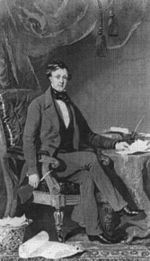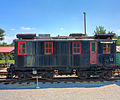Portal:Trains
Portals → Technology → Transport → Trains
The trains portal
|
In rail transport, a train is a vehicle or (more frequently) a string of vehicles capable of being moved along a continuous line of rails or other guideway for the purpose of conveying freight or passengers between points on a predetermined route. The train may be hauled or propelled by one or more vehicles designed exclusively for that purpose (locomotives) or may be driven by a number of motors incorporated in all or several of the vehicles (multiple units). As of 2018[update], there are approximately 1,052,000 kilometres (654,000 mi) of railway track in use worldwide. (World Bank (via Archive.org)) |
|
Selected article of the week
Thomas Brassey (7 November 1805 – 8 December 1870) was an English civil engineering contractor and manufacturer of building materials who was responsible for building much of the world's railways in the 19th century. By 1847, he had built about one-third of the railways in Britain, and by time of his death in 1870 he had built one mile in every 20 miles of railway in the world. This included three-quarters of the lines in France, major lines in many other European countries and in Canada, Australia, South America and India. He also built the structures associated with those railways, including docks, bridges, viaducts, stations, tunnels and drainage works. As well as railway engineering, Brassey was active in the development of steamships, mines, locomotive factories, marine telegraphy, and water supply and sewage systems. He built part of the London sewerage system and was a major shareholder in Brunel's The Great Eastern, the only ship large enough at the time to lay the first transatlantic telegraph cable across the North Atlantic, in 1864.
Recently selected: Channel Tunnel - Indiana Railroad - SR Class Q1
Selected image of the week
The Royal Gorge in Colorado (United States) a canyon of the Arkansas River. Visible in the photo is the "hanging bridge" with its unusual cross-canyon girders.
The discovery of silver and lead near Leadville in 1877 prompted a race to build rail access to the area. The Royal Gorge was a bottleneck too narrow for both the Atchison, Topeka and Santa Fe Railway and the Denver and Rio Grande Western Railroad to pass through, and there was no other reasonable access to the South Park area. Both railroad crews thus took to fighting the Royal Gorge Railroad War, two years of essentially low-level guerrilla warfare between the two companies. Federal intervention prompted the so-called "Treaty of Boston" to end the fighting. The D&RGW completed its line and leased it for use by the Santa Fe.
Recently selected: Swedish railway signal - Lartigue monorail - Preserved German steam locomotive
Did you know...
- ...that the opening ceremonies of the Galway to Clifden railway were very sparsely attended because the event date was a strict church holiday and was reserved for attending church services?
- ...that following heavy damage to the Galveston Island Trolley track and cars from Hurricane Ike in 2008, substitute service with replica buses was operated until service resumed in October 2021?
- ...that although the former Santa Fe Railway's Galesburg station was demolished after regular passenger service to the station ended in 1996, the site is still used if derailments cause trains to use the Chillicothe Subdivision instead of the Mendota Subdivision?
- ...that the Fuzhou–Xiamen railway, which opened in 2010, was so heavily used that it reached capacity in 2015, spurring construction on the parallel Fuzhou–Xiamen high-speed railway for CRH passenger train services?
Selected anniversaries
- June 11
- 1881 – The Atchison, Topeka and Santa Fe Railroad connects to El Paso, Texas (pictured).
- 1884 – The Pine Bluff and Swan Lake Railway, in Arkansas (later to become part of the Cotton Belt Railroad), is incorporated.
- 1905 – The Pennsylvania Railroad inaugurates the fastest freight train schedule in the world, operating between Chicago, Illinois, and New York City in 18 hours.
- 1944 – Michael R. Haverty, president of the Atchison, Topeka and Santa Fe Railway 1989-1995 and president of the Kansas City Southern Railway 1995-present, is born.
Train News
- July 24, 2021 – Atchison, Topeka and Santa Fe No. 2926, a 4-8-4 steam locomotive built by Baldwin Locomotive Works in 1944, moves under its own power for the first time since Christmas Eve of 1953, after nearly twenty-two years of being rebuilt by volunteers. The locomotive will be put into mainline excursion service. (NMSL&RHS, Trains Magazine on Facebook)
- May 5, 2021 – Steamtown National Historic Site completes thorough cosmetic overhaul on Union Pacific 4-8-8-4 Big Boy No. 4012, which is moved back on static display before National Train Day. (NEPA Scene)
- April 2, 2021 – 2021 Hualien train derailment – A Taroko Express train operated by the Taiwan Railways Administration (TRA) derails at the north entrance of Qingshui Tunnel in Heren Section, Xiulin Township, Hualien County, Taiwan, killing 49 people and injuring at least 200 others. North of Hualien City a construction truck had fallen down a slope onto the tracks. The eight-carriage train derailed after colliding with the truck, and then came to a rest in the tunnel, with severe damage and many casualties. (Bloomberg, CNN, CNA, New York Times, Financial Times)
- December 31, 2020 – Following a complete restoration, Chesapeake and Ohio 1309, a 2-6-6-2 Mallet locomotive built by Baldwin Locomotive Works in 1949, the last steam locomotive built by Baldwin for the North American market, is operated under its own power for test runs. When returned to service on the Western Maryland Scenic Railroad, it will be the largest steam locomotive in regular scheduled service in the United States and take 2-8-0 No. 734’s place as the largest active steam locomotive in the state of Maryland. (Trains.com Newswire)
- September 28, 2020 – Amtrak operates a test run using one of the 28 new Avelia Liberty trains manufactured by Alstom along the full length of the Northeast Corridor to Boston South Station. Previous test runs had occurred from Washington, D.C., only as far north as New Jersey and Delaware. Barring any problems, the trains are expected to enter regular service on the route in 2021. (Universal Hub)
- June 13, 2020 – The Bay Area Rapid Transit Silicon Valley BART extension opened its stations in Milpitas and North San Jose. (San Jose Spotlight, SF Gate)
General images
WikiProjects
WikiProject Trains (Shortcut: WP:TWP)
- WikiProject Stations (WP:STA)
- WikiProject Streetcars (WP:TRAM)
- WikiProject Rapid transit (WP:RTPJ) inactive
- By region:
- WikiProject Metros of the former Soviet Union (WP:SOVMETRO) inactive
- WikiProject Indian railways (WP:INRW)
- WikiProject Trains in Japan (WP:TJ)
- WikiProject New Zealand Railways (WP:NZR)
- WikiProject Pakistan Railways (WP:PKR) inactive
- United Kingdom
- United States
- Fictional rail transport topics:
Note: WikiProjects marked as inactive are retained pending future editing activity
Subcategories
Things you can do
See also Wikipedia:WikiProject Trains/Todo and Wikipedia:Pages needing attention/Railroads
Associated Wikimedia
The following Wikimedia Foundation sister projects provide more on this subject:
-
Commons
Free media repository -
Wikibooks
Free textbooks and manuals -
Wikidata
Free knowledge base -
Wikinews
Free-content news -
Wikiquote
Collection of quotations -
Wikisource
Free-content library -
Wikiversity
Free learning tools -
Wiktionary
Dictionary and thesaurus
























































































